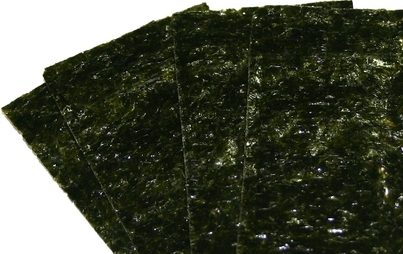Introduction
Discussions as to how
one may obtain adequate
quantities of vitamin B12 on
a plant based lifestyle, without the aid
of supplementation, attract considerable
fear and controversy; plant sources of bioavailable B12 are, however, as we shall see, available.
One should, nevertheless, irrespective of dietary intake, monitor whether absorption is being facilitated by the digestive system, via the measure of laboratory testing, since B12 deficiency is on the increase, due to some people’s inability to uptake B12 from dietary intake, and cobalt deficiencies in over farmed soil.
Korean laver/nori (Porphyra sp.) and Chlorella have been shown to contain active B12, review the evidence below, in order to gain an understanding thereof. Furthermore, there are numerous other promising plant sources of B12, however, as of mid-2013, we are not in a position to propose other suitable sources, since such have not been amply tested.
Discussions as to how
one may obtain adequate
quantities of vitamin B12 on
a plant based lifestyle, without the aid
of supplementation, attract considerable
fear and controversy; plant sources of bioavailable B12 are, however, as we shall see, available.
One should, nevertheless, irrespective of dietary intake, monitor whether absorption is being facilitated by the digestive system, via the measure of laboratory testing, since B12 deficiency is on the increase, due to some people’s inability to uptake B12 from dietary intake, and cobalt deficiencies in over farmed soil.
Korean laver/nori (Porphyra sp.) and Chlorella have been shown to contain active B12, review the evidence below, in order to gain an understanding thereof. Furthermore, there are numerous other promising plant sources of B12, however, as of mid-2013, we are not in a position to propose other suitable sources, since such have not been amply tested.
“…substantial amount (133.8 μg/100 g) of vitamin B12 was found in dried purple laver, seasoned and toasted laver products contained lesser vitamin B12 contents (about 51.7 μg/100 g). The decreased vitamin B12 contents in the seasoned and toasted laver products, however, were not due to loss or destruction of vitamin B12 during the toasting process. Silica gel 60 thin layer chromatography−bioautogram analysis indicated that all Korean laver products tested contain true vitamin B12, but not inactive corrinoid compounds. In vitro gastrointestinal digestion experiments indicated that digestion rate of vitamin B12 from the dried Korean purple laver was estimated to be 50% under pH 2.0 conditions (as a model of normal gastric function). These results suggest that Korean purple laver products would be excellent vitamin B12 sources for humans, especially vegetarians.”(1)
“…the amount of total vitamin B12 in the dried purple laver was estimated to be 54.5 and 58.6 (SE 5.3 and 7.5 respectively) ΜG/100 g dry weight by lactobacillus bioassay and chemiluminescent assay with hog intrinsic factor respectively. the purple laver contained five types of biologically active vitamin b12 compounds (cyano-, hydroxo-, sulfito-, adenosyl- and methylcobalamin), in which the vitamin b12 coezymes (adenosyl- and methylcobalamin) comprised about 60 % of the total vitamin b12. when 9-week-old vitamin b12-deficient rats, which excreted substantial amounts of methylmalonic acid (71.7(se 20.2) μmol/d) in urine, were fed the diet supplemented with dried purple laver (10 μg/kg diet) for 20 d, urinary methylmalonic acid excretion (as an index of vitamin B12 deficiency) became undetectable and hepatic vitamin B12 (especially adenosylcobalamin) levels were significantly increased. These results indicate that vitamin B12 in dried purple laver is bioavailable…”(2)
“In our study of Korean centenarians for their longevity, the apparent nutritional imbalance in the traditional semi-vegetarian diet raised a special attention, especially on vitamin B12 status, supplied by animal foods. Interestingly, we found that the prevalence of vitamin B12 deficient Korean centenarians was not higher compared with those from Western nations with animal-oriented traditional foods. We assumed that there might be some unveiled sources for vitamin B12 in the Korean traditional foods. Screening of vitamin B12 contents has revealed that some traditional soybean-fermented foods, such as Doenjang and Chunggukjang, and seaweeds contain considerable amounts of vitamin B12.” (3)
“True vitamin B12 is the predominate cobamide of the eukaryoticalgae (green and purple lavers and chlorella sp.). Feeding the purple laver to vitamin B12-deficient rats or humans significantly improved the vitamin B12 status... …Pseudovitamin B12 (an inactive corrinoid compound) predominated in all edible cyanobacteria tested, Spirulina sp., Nostoc commune (Ishikurage), Aphanothece sacrum (Suizenji-nori), and Aphanizomenon flosaquae. They are not suitable for use as a vitamin B12 source, especially for vegetarians. Some of these edible cyanobacteria have the ability to de novo synthesize pseudovitamin B12, which can mainly function as the coenzyme of cobalamin-dependent methionine synthase involved in DNA synthesis.” (4)
“In vegetarians, there was a positive correlation between the vitamin C intake and serum ferritin levels as well as between the laver intake and serum vitamin B-12 levels… …On the basis of its high content of true vitamin B- 12, Korean laver can be recommended for vegetarians as a dietary source of vitamin B-12.” (6)
"To measure the biological activity of B12 in lyophilized purple laver (Porphyra yezoensis), the effects of laver feeding were investigated in B12-deficient rats.72 Within 20 days of initiating a diet supplemented with dried purple laver (10μg of B12/kg diet), urinary methylmalonic acid excretion became undetectable, and hepatic B12 (especially coenzyme B12) levels increased signifi-cantly. These results indicate that B12 from the purple laver is bioavailable in rats." (7)
"The results presented here indicate that Chlorella tablets contain substantial amounts of B12 so that they may be suitable for use as a B12 source" (8)
"These results suggest that Chlorella supplementation significantly reduces the risk of pregnancy associated anemia, proteinuria and edema. Chlorella supplement may be useful as a resource of natural folate, vitamin B-12 and iron for pregnant women"(9)
References
1) Characterization of Vitamin B12 Compounds from Korean Purple Laver (Porphyra sp.) Products. Emi Miyamoto, Yukinori Yabuta, Chung Shil Kwak, Toshiki Enomoto, and Fumio Watanabe Journal of Agric Shigeo Takenaka, Sumi Sugiyama, Shuhei Ebara, Emi
2) Miyamoto, Katsuo Abe, Yoshiyuki Tamura, Fumio Watanabe, Shingo Tsuyama and Yoshihisa Nakano (). Feeding dried purple laver (nori) to vitamin B12-deficient rats significantly improves vitamin B12 status. British Journal of Nutrition, 85, pp 699-703. doi:10.1079/BJN2001352. ultural and Food Chemistry 2009 57 (7), 2793-2796
3) Chung Shil Kwak, Mee Sook Lee, Se In Oh, and Sang Chul Park, “Discovery of Novel Sources of Vitamin B12 in Traditional Korean Foods from Nutritional Surveys of Centenarians,” Current Gerontology and Geriatrics Research, vol. 2010, Article ID 374897, 11 pages, 2010. doi:10.1155/2010/374897
4) WATANABE FUMIO
Vitamin B12 from Edible Algae-from food science to molecular biology-
Vitamins
VOL.81;NO.2;PAGE.49-55(2007)
5) Determination of Cobalamin in Nutritive Supplements and Chlorella Foods by Capillary Electrophoresis−Inductively Coupled Plasma Mass Spectrometry
Jing-Huan Chen and Shiuh-Jen Jiang
Journal of Agricultural and Food Chemistry 2008 56 (4), 1210-1
6) Yujin Lee Dipl oec Troph and Michael Krawinkel PhD
The nutritional status of iron, folate, and vitamin B-12 of
Buddhist vegetarians
Asia Pac J Clin Nutr 2011;20 (1):42-49
7) Biologically Active Vitamin B12 Compounds in Foods for Preventing Deficiency among Vegetarians and Elderly Subjects
Fumio Watanabe, Yukinori Yabuta, Yuri Tanioka, and Tomohiro Bito
Journal of Agricultural and Food Chemistry 2013 61 (28), 6769-6775
8) Purification and Characterization of a Corrinoid Compound from Chlorella Tablets as an Algal Health Food
Hiromi Kittaka-Katsura,†, Tomoyuki Fujita,‡, Fumio Watanabe,*,§ and, and Yoshihisa Nakano‡
Journal of Agricultural and Food Chemistry 2002 50 (17), 4994-4997
9) Chlorella pyrenoidosa supplementation reduces the risk of anemia, proteinuria and edema in pregnant women.
Nakano S, Takekoshi H, Nakano M.
Plant Foods Hum Nutr. 2010 Mar;65(1):25-30. doi: 10.1007/s11130-009-0145-9.
Plant Sources of B12

